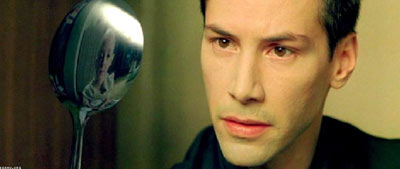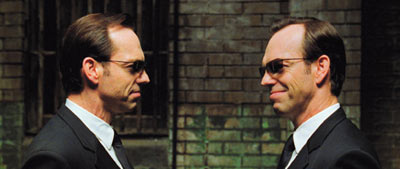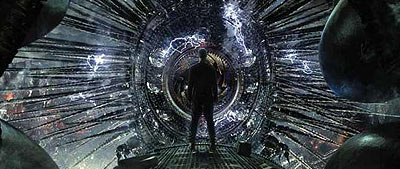The Matrix Revisited
Published on November 29th, 2010 in: Issues, Movies, Science and Technology, Science Fiction, Three Of A Perfect Pair |By Lisa Anderson
Seraph: Did you always know?
Oracle: No, no I didn’t. But I believed. I believed.
—The final lines of dialog of The Matrix Trilogy

In 1999, the movie going public got its mind blown. The Matrix, directed by Andrew and Larry (Lana) Wachowski, used cutting-edge technology to draw on a range of stylistic influences, from Hong Kong action movies to Cyberpunk. What really set the film apart, though, was it’s heady blend of ideas and symbols from Christianity, Eastern spirituality, and Western Philosophy.
Its sequels, The Matrix Reloaded and The Matrix Revolutions were filmed together, and released within a few months of each other in 2003. While The Matrix is almost universally loved, the rest of the trilogy disappointed fans and critics. As a result, the original often gets filed under “things that should have been left alone.” I also have issues with the film craft of the last two movies, but I feel that the story itself ended the way it had to.
The Matrix is an almost perfect movie, both in terms of visuals and narrative. It is of one piece, without any visible joints or seams. It’s also the most accessible of the three: everyone knows what it’s like to feel like people or circumstances in their life are trying to control them. Everyone knows what it’s like to wonder if we’ve sacrificed our freedom—to the government, to the world of commerce, or to organized religion—in favor of superficial comforts. For my part, I was a political science student at the time, and as I learned about corporate power and global economic disparity, Western lifestyle fitted into into the role of the Matrix with disturbing ease.
Nevertheless, it occurs to me to wonder if a movie like The Matrix would be as successful in our current ideological climate. While it does seem like someone could bring almost any political stripe to the film, the protagonists are regarded as terrorists. More importantly, anti-authoritarianism has become a tougher sell these days. After all, many critics considered the anarchist bent of the Wachowski’s follow-up, 2006’s V for Vendetta, to be in bad taste.
As the series progressed, however, the story revealed itself to be more than a simple tale of exploitation and resistance. This is what threw people off: in the end, the Machines are not defeated. The audience has been waiting for Neo to tear down the walls of Wonderland, and instead they get a negotiated peace, bought with the deaths of the leading couple.

The first explanation for this that occurred to me was: the sentient programs in the Matrix have a right to exist. Or at least as much of a right as people do. Neo’s nemesis and foil, Agent Smith, may be destroyed in the end, but that is because he was overriding the human minds in the Matrix and more benign programs like the Oracle. Little Sati, with her loving parents, Rama-Kandra and Kamala, is how Neo (and the audience) comes to understand that programs are just like humans: they are self-aware, they didn’t ask to exist, and they are capable of choice. Between the terrifying squiddies and the fearsome Deus ex Machina with which Neo speaks, the Machines themselves are much less sympathetic . . . but the programs depend on them.
The second key to understanding the arc of the story is that Neo’s sacrifice is made only for those who embrace it. In the last scene of Revolutions, the Oracle asks the Architect of the Matrix if he’s going to release “the ones who want out.” He answers that he will. I assume that they’re referring not only to humans who aren’t happy in the Matrix, but also to unwanted programs, who would ordinarily face deletion or have to find passage out with the Trainman. This shouldn’t be as surprising as it is: in the first movie, Morpheus tells Neo that most adults aren’t ready to be unplugged. Neo’s martyrdom, in this way, follows the Christian imagery of the series to its natural conclusion; and the choice left to those within the Matrix fits with the Buddhist ideas (illusion, enlightenment, rebirth) in which the films are also rooted.
In the end, the story is about power within, rather than external power struggles. Questions of oppression and victory are less important than questions of faith and choice, and ego vs. purpose. The real heroic journey in the story is to know oneself, which means knowing what you believe. Most of the characters are on that journey in their own way.
None of this should imply that I don’t have problems with Reloaded and Revolutions. I find Revolutions to be closer in quality to The Matrix than to Reloaded, but as the story got more ambitious, it became impossible to maintain the same level of quality. The already-dense meaning of what was going on becomes harder to follow, and the archetypes become less easily identifiable. (An Oracle, we’ve heard of. A Merovingian? Not so much.) The majority of the images from The Matrix feel like the way Michelangelo described his sculptures: something revealed rather than created. While the sequels have such visuals, too, they feel more cluttered with things that aren’t natural to them.

Without doubt, the Matrix trilogy was hugely influential. Just as an example, “Bullet Time”™ has been used in films as diverse as Kung Pao: Enter the Fist and Scott Pilgrims vs. The World. Projects like Inception are not only the heir to the slick visual style of The Matrix, but also to the excitement still generated by high-concept, mind-bending storylines. This influence is not likely to wane anytime soon. While the first movie can be enjoyed on its own, delving into the sequels—imperfect as they are—still provides a rich and challenging experience.
One Response to “The Matrix Revisited”
December 7th, 2010 at 3:43 pm
Lisa, I have no idea why you wouldn’t have wanted to write about the Matrix trilogy. It can’t be haunting you right now, could it?
Have you read the comics series, The Invisibles? Your comments about revolution and change reminded me of one of the first conversations King Mob has with the Marquis de Sade. In reference to making room for both the humans and the programs, K.M. said the Invisibles were aiming to create a world where everyone could live their own reality, even the enemy. Sound familiar? Also you observed that some adults don’t want to be unplugged. As K.M. said some people miss the point that these great teachers aren’t here to tell us how to live, rather they are simply showing us the way to build our own paths. Of course, some people don’t want that; they want to be told where and when to p1ss.
Time limit is exhausted. Please reload the CAPTCHA.